How To Repair Rotten Joist Ends
Structural Timber Repairs – Guide Covering How To Repair Structural Timbers Including Flooring Joists, Covering Joists, Joist Ends and Carrier Beams From Dry out Rot, Wet Rot and Woodworm Damage
Structural timber repair and treating joists against moisture rot, dry out rot and insect damage. This guide covers everything you lot need to know virtually repairing structural timbers including roofing joists and flooring joists when they have been damaged by wet rot, dry rot and insect attack such as that from woodworm beetle. Nosotros show you how to repair joist ends, carrier beams and wall plates with out the need to remove them.
Damp and timber joists exercise non mix well. In fact clammy and any kind of structural timber, be it roof trusses, floor joists, doorframes, window frames and sills make for (largely) one or more of 3 types of real damage.
We expect closely at wet rot and its causes and effects, the lasting impairment of dry rot and how insect attack from woodworm and other wood boring beetles can severely compromise the structural (and other) timbers in the home.
If you need any help with any type of floor repair, structural timber repair, joist repair or timber treatment, Property Repair Systems expert staff will be pleased to give you completely complimentary, no obligation communication on 01626 872 650. The data you need may be in the projection below. If not, call them.
Damage to Timber Joists and Floors
There are three primary types of timber impairment, but they are all acquired by clammy.
Timber will start to decay at above 18% wet content (in boilerplate softwood species, similar an ordinary Pine), so elimination of dampness is our main concern. 18% dampness means nearly one-5th of the timber is damp and this can happen purely equally a result of condensation, leaking roofs, rise damp and other forms of exposure to wet.
Timber in the abode should be inspected periodically to brand sure information technology is not exposed to any of these problems.
Types of Impairment to Structural Timber
Wet Rot
When an area, or section is exposed to water, taking it'south wet content above 18%, fungus or mycelium can start to "feed" off the timber and grow into and from the woods.
There are many types of mucus that make upwardly the wet rot category, they include Coniophora Puteana and Poria Vaillantii with Coniophora being the primary culprit. The mucus feeds off the wood making it soft and spongy.
Wet rot is often first noticed when floors, peculiarly ground-floor, floor joists become springy under foot. Possible causes of wet-rot are.
- Unpainted and untreated timber exposed to water from roof
- Condensation water arising from lack of ventilation to roof or floor timbers especially with hollow floors. Condensation can besides desperately outcome window sills, when condensation moisture is allowed to collect on window surfaces and run down and collect on a sills surface
- Water accumulating and existence soaked up by timbers from leaking pipes, leaking wastes (bath or sink), hoses from washing machines and dishwashers etc…..
- Rising clammy making floor slabs and/or walls wet which in plough tin can touch the backs of skirting boards and door frames where no paint is usually applied
For more than information on identification of wet rot, how it is acquired and the remedies for it, become to our project page.
Dry Rot
Starting in a wet area of the timber, dry rot or Serpula Lacrymans is some other mucus which literally sucks the life out of timber.
Different moisture rot withal, when dry rot has consumed all the wet from ane damp area of timber, it searches out some other and travels over all manner of surfaces to get to it. This fashion it can destroy whole properties if it's journey remains undetected.
The causes of the damp which attracts dry rot can exist the same as wet rot simply the spores of the dry out rot mucus germinate and and so spread in very fine, nigh cob-web like strands. These strands can travel beyond woods, plaster, brick and any surface where they can get a concord in their search for new clammy patches of timber.
Ways to identify dry rot include:
- Large mushroom type growths on the timber surface
- Large, deep (generally square shaped) cracks in the timber surface and cubing of timber
- Orange colour spots or spores around the mushrooms or whatever other growth appearing on the timber
- Strings which look similar a very dense cobweb running across surfaces.
For more data on dry rot, go to our information on dry rot identification, causes and remedies.
Insect Attack
Damp can concenter woodworm beetles such as the Death Watch Beetle (Xestobium Rufovillosum) and woodboring Weevils (Pentarthrum Huttoni and Euophryum Confine) at the most farthermost degree.
In fact, the woodboring weevil will generally be constitute in timber where fungus has started to take root. The causes of the damp can still be the aforementioned merely the insect attack will be fairly local. Virtually wood tedious insects prefer timber with a fairly high moisture content.
Damage from woodworm of any kind tin originate either in the growing tree, where there is plenty of moisture or in the timber yard where near timber planks are stacked, very close to each other, allowing trivial or no ventilation and the timber gets damp through both rain and condensation.
Signs of attack from wood boring insects or woodworm are usually the emergence holes (between 1mm and 1.5mm diameter). For more information see our project on woodworm and how to identify it.
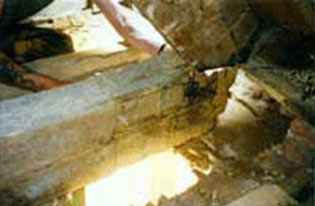
Joist damaged by damp – Wet timber invites problems from fungi and insects
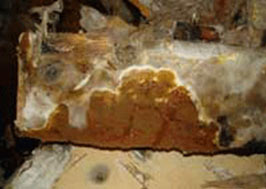
Harm to brick caused past dry rot soaking upward moisture as it travels across
Methods for Repairing Structural Timbers Safely
The power to effect repairs on timber joists, beams, rafters, purlins, floorboards and all forms of structural timbers is not express to today'southward techniques.
Carpenters have been splicing timbers with special joints for hundreds of years with many of these repairs nevertheless evident today in many onetime buildings and indeed, ships!
To make the right choice for your repair y'all may need some assist over and above that offered on this page. If then, and so Property Repair Systems are at hand. We take worked with them for a number of years and tin confirm their expertise in this field. Give them a call on 01626 872 650.
Firstly, look for the source of the trouble before you bargain with the effects.
As good as modern methods are at repair and prevention of assault from h2o, moisture and wood tiresome insects, information technology is tempting fate to just carry on with the repair until y'all have adequately diagnosed the crusade of the problem.
If it is a damp problem, wait for (and repair) the source of the damp.
You may need to re-roof or take a expect at how your roof tiles are stock-still to your roof. It may exist that they are not at the correct spacing (estimate) and the rain is bravado upwards underneath them.
It could as well be that your chimney or other flashing'southward are non fitted correctly or have slipped out of their joints.
Information technology could exist that condensation is the cause and has built up considering of lack of ventilation's. This can be addressed on our pages dealing with the effects of condensation.
If leaking pipes or hoses are at fault you need to repair immediately to stop further harm to the new piece of work you are nigh to do and if the damp problem has arisen because of a faulty damp proof form and so this needs to exist addressed urgently.
Repairing Joist Ends
The supported ends of joists can become damp considering they remainder inside or close to the support walls and hands absorb h2o from damp soil, boiling air or h2o leaks.
This tin include h2o traveling over the top of the brickwork through loose or cleaved tiles and blocked gutters. Wall plates can be affected as well.
If at that place is piffling or no ventilation in the damp area, the moisture will not have the take chances to evaporate and the timber will develop fungus as explained above therefore any repair or treatment must include attention to the Air Bricks or other ventilation (See our projection roofing air bricks and vents).
There are a number of ways to repair structural timber. The easiest way to repair joist ends is to fit joist repair plates.
These come as a pair of ″L″ shaped, metal plates complete with screws and instructions.
They have the advantage that joists are extended back into or onto the original bearing.
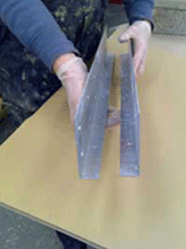
A pair of joist repair plates
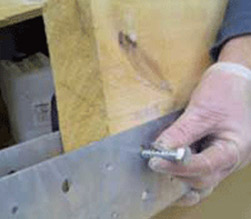
Joist repair plates are bolted to the sides of damaged joists
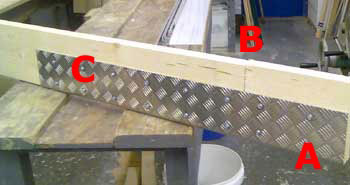
Joist repair plates fixed to timbers
How to Position, Prepare and Align Joist Plates
The best way to repair the end of a joist is to remove the damp or affected finish later the flooring or ceiling has been propped up as ane would if removing or forming an opening through a load-begetting wall, with Acrow Props.
A new slice of timber is cut (A) to supervene upon the damaged slice and the joists plates are positioned ether side of the joists with the stop of the joist plate correct upward against the border of the timber so it is the joist plate that site on the bearer (A).
The joist plate is bolted to the timber making the joint (B) as strong equally the original joist. The length of the joist plate on the original side of the joist (C) is usually at least twice that of the slice that replaces the damaged section (A).
Treating Joist Ends
As well every bit a joist plate, if required, the end grain cutting (A) and the back up area should be thoroughly treated with Boron Ultra Gel and a piece of damp proofing textile, such as DPC plastic should then be placed underneath, to prevent damp from finding its style from the wall into your new timber. Employ pre-treated timber if possible.
The Boron Gel is diluted with water to create a 5% solution and painted on the ends, and joints of timber. This so provides a barrier to forestall attack from woodworm and also will fend off dry out rot.
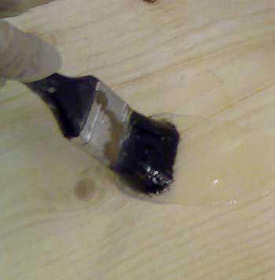
Applying Boron gel by brush to new or damaged timber
Providing Plenty Air Menses to Prevent Damp
Most backdrop will feature air bricks – these allow the flow of air either in roof spaces or under suspended floors and prevent the build-up damp and moisture. When it comes to air bricks on the exterior wall of your property you should ensure that there is at least one brick per two.25 meters of outside wall length.
Yous will too have to ensure that any outside footing is significantly below any air bricks as if not, this may restrict air period and damp issues may result.
To these ends, ensure that air bricks are clear from soil build-up, pathways or tarmac and other obstructions.
Repairing Carrier Beams and Support Beams
Carrier or back up beams are normally larger timbers than joists and in respect to this, it might not be possible to use the joist repair plate arrangement previously mentioned.
Carrier and support beams are unremarkably (these days) installed as steel RSJ'southward but in older backdrop or barn conversions these may well be existing timbers or indeed new, very large timbers, to maintain the integrity of the building and also to maintain it'southward traditional aesthetic wait. There may also be certain conservation rules that stipulate that any repairs should maintain an existing look.
If timbers are larger than 10 x 2 inches (or 250mm x 50mm) then the most suitable repair volition be to use a Timber-Resin Splice.
This organization commonly comes in the grade of a kit for easy use and provides a new piece of timber (D), with zinc plated loftier tensile metal bars or rods (E).
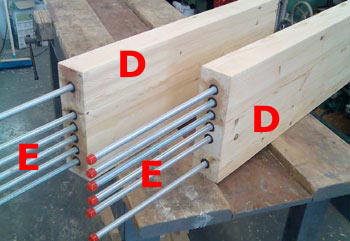
Using resin bonded bars to repair joists and rafters
These loftier tensile bars volition be pre-bonded into 1 end of the timber beam, ready for y'all to fit using the resins provided in the kit.
The footing of this repair method involves firstly supporting the timber so that the load weight is taken off the supporting point and the weight from the above floor or roof is stable and then the damaged section of timber is cut off far enough along the length of the timber and then that only undamaged timber is left. Obviously now your timber is going to exist too short to reach the original support.
To resolve this, in the length of timber that is left you will at present need to cut a slot in the top of information technology that is slightly longer than the protruding loftier tensile bars in the replacement timber splice you have. Now y'all can place your timber splice up to the existing timber with the high tensile bars resting in the slot that you lot take only cutting.
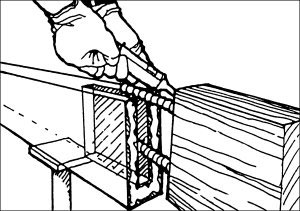
Slot cut in existing timber to have steel rods in timber splice
Finally, the resin supplied with the kit is poured into the slot, bonding the high tensile bars into the existing timber. Once the resin has cured and set, the supports can be removed and the new splice section volition so residual on the original supporting indicate creating your newly repaired timber.
If y'all would like some more information on the process of using joist splice kits to extend the joist to the wall plate and mount information technology back in position have a look here.
Treating Carrier Beams and Wall Plates
Boron is an excellent treatment for damp timber. It can be practical as a paste and inserted into 10mm holes drilled in the timber.
The backdrop of Boron volition impale all woods deadening insects every bit well equally killing and preventing further growth of all fungicidal spores which are the causes of moisture and dry rot.
The image below shows boron paste being injected in to a 10mm hole drilled in a new piece of timber which is most to be fastened by joist plates, to an existing roof timber.
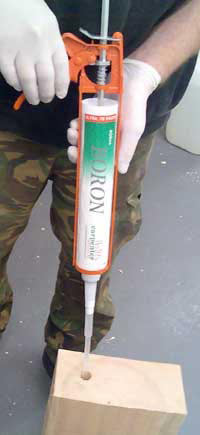
Boron paste as used in timber joists and rafters
A surface applied Boron Gel can too be used as can the paste and solutions mentioned higher up. Manufacturers advice (FREE) from Property Repair systems should be sought on 01626 872 650 before deciding which method to use for repairing and preventing further damage of your roof or floor timbers.
Source: https://www.diydoctor.org.uk/projects/rep_struc_joist.htm#:~:text=The%20easiest%20way%20to%20repair,or%20onto%20the%20original%20bearing.
Posted by: muellerpory1963.blogspot.com


0 Response to "How To Repair Rotten Joist Ends"
Post a Comment